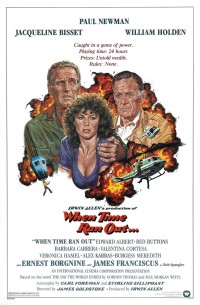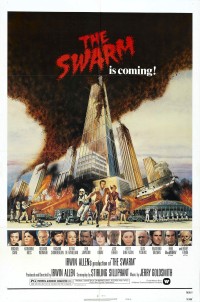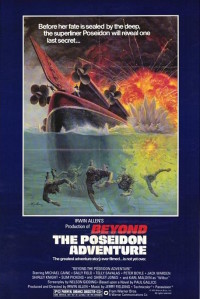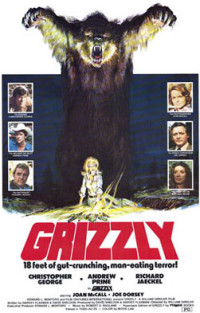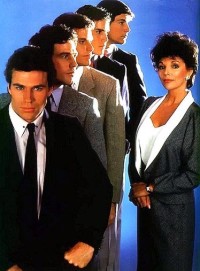 The glitzy soap Dynasty (1981- 89) reached the heights of international popularity in the early 1980s. Aaron Spelling and the creative team behind the show crafted this made-for-television gem as a showcase for its star Joan Collins. Making of a Male Model (1983) is a glamorous peek into the dog eat dog world of modeling… male modeling to be exact.
The glitzy soap Dynasty (1981- 89) reached the heights of international popularity in the early 1980s. Aaron Spelling and the creative team behind the show crafted this made-for-television gem as a showcase for its star Joan Collins. Making of a Male Model (1983) is a glamorous peek into the dog eat dog world of modeling… male modeling to be exact.
What it’s all about: While en-route to a photo shoot, superstar modeling agent Kay Dillon (Collins) is nearly run off the road North by Northwest-style by some yokel in a crop dusting plane. The pilot turns out to be Nevada ranch hand Tyler Burnett (Jon-Erik Hexum) the soon-to-be male model of the title.
“Have you ever considered a career in modeling?” Kay asks, looking him up and down with her expert eye.
“Huh-uh, should I have?”
When a local gal passes Tyler over, one has to question her sanity. Giving up Jon-Erik Hexum for a guy who drives a Trans Am? Some people need to get their priorities straight. With no place and no girl to call his own, Tyler heads to the big city.
Arriving in New York dressed in his finest Stetson and sheepskin coat, Tyler meets his new roommate. Chuck is a bitter, emotionally crippled, washed up fellow model. Noticing Chuck’s black eyes, Tyler asks, “You get into a fight or somthin’?”
“Yeah,” he answers, “with my plastic surgeon.” In an over the top performance by Jeff Conaway, Chuck is a veritable walking billboard for the evils of fame, fortune and excess.
Meanwhile Kay must turn her diamond in the rough into a polished gem. “He’s got that natural raw sex look.” But Tyler hates all the primping and preening and wants to go on his first job interview just as he is.
At a casting call the next day, photographer Arte Johnson shouts at Tyler, “Take off your shirt. I wanna see your body.” Tyler is rejected, despite the fact that Hexum has the face and body of a Greek god.
Perhaps Kay was right. Tyler relents and is soon being plucked, dyed and trimmed in a make-over montage that transforms Tyler from a handsome bumpkin to an even more handsome metrosexual-type. The song used to score the scene is pretty memorable too. The funky R&B/disco tune is reminiscent of the type of music they use in porn. Bum-chicka-bow-wow.
Back at their apartment, Tyler pumps some iron and waits for word on his first job while Chuck drinks like a fish and throws himself a pity party. “It’s a strange apple this Big Apple” he muses. Thankfully the phone rings with news that Tyler got the catalog job after all. Just wait until he sees the clothes he has to wear, which might be described as 80’s republican chic.
After his first successful job, Kay takes Tyler to a costume ball. Dressed as a rhinestone cowboy, Tyler sneers at the industry types around him, “A bunch of weirdoes and queers.”
“You know of course that Chuck is gay.”
“It’s different he’s a friend of mine.”
“Then why are you so damn judgmental about all the others?” Kay asks. “Why don’t you just accept the fact that we are all free to live our own lifestyle and do exactly as we please.” Quite a progressive attitude for 1983, but the life lessons are put on hold when ad exec Kevin McCarthy accosts Kay. Tyler does his costume proud by coming to her rescue and roughing up the drunken McCarthy. Impressed by his gallantry, Kay finally bursts the bubble of sexual tension between them and beds Tyler in her ritzy Central Park West apartment. A romantic at heart, Tyler wants them to live together, but Kay is a modern career-driven gal and insists on remaining unattached.
Tyler’s next audition happens to be for the same ad exec that he manhandled at the costume party. Not even McCarthy is immune to the charms of Jon-Erik Hexum. Tyler lands the commercial for Fever cologne and instantly becomes a huge star.
“Try it…and let her catch the fever”, he sexily intones.
While Tyler’s career soars, Chuck’s has landed in the gutter. A scenery-chewing, drunken mess, he bemoans his fall from supermodel grace when he doesn’t get a gig standing next to a car at an auto show. He’s too old. Waving his drink around like he’s in a road show production of Who’s Afraid of Virginia Wolf? Chuck berates Tyler’s success. “What do you care? Mr. Sex Symbol of these United States.”
For Tyler, fame has begun to loose its luster. After returning from a job in L.A. he finds that Kay has been seeing someone else and that his roommate Chuck has died of a drug overdose. “They didn’t give you much time on the yellow brick road did they my friend?”
On a shoot in Acapulco, Tyler hooks up with blonde model and smokes some post-sex pot. Reefer is a gateway drug. Did living with Chuck teach you nothing Tyler?
Soon he’s boozing and partying and missing jobs. “You can be unmade as quickly as you were made.” Kay warns.
“Just like a bed huh? Well you should know all about that.”
Tired of the fast lane, Tyler heads back home to Nevada where he fulfills his dream of owning his own farm. Kay finds him working on the ranch and begs him to return and finish the job he walked out on. If Tyler doesn’t come back the ad agency could sue for breach of contract. Threatened with the loss of his land, Tyler returns to the city for one last commercial.
After the shoot, Tyler stops by Kay’s office to say goodbye. She tries to talk him into a television series he’s been offered, but his mind is made up. Our attractive cowboy/supermodel borrows a horse from a hansom cab driver and rides off into the proverbial sunset… down 5th Ave.
In conclusion: Joan Collins’ portrayal of Kay could never be described as low-key, but compared to the outrageous antics of Alexis on Dynasty, she seems almost saintly. Fans of Collins won’t be disappointed though. There’s enough shoulder-padded glamour (courtesy of designer Nolan Miller) and sex in Making of a Male Model to satisfy any Dynasty fan.
Unfortunately, Jon-Erik Hexum is best remembered as a morbid pop culture footnote. He died after an on-set accident (Cover Up 1984-85) with a prop handgun. He had a breezy charm that made him instantly likable. Hexum’s goofy grin gave the impression that, despite his hunk status, he didn’t take it too seriously. It was those looks and charm that made him ideal for television. It would have been interesting to see how his career could have grown.


